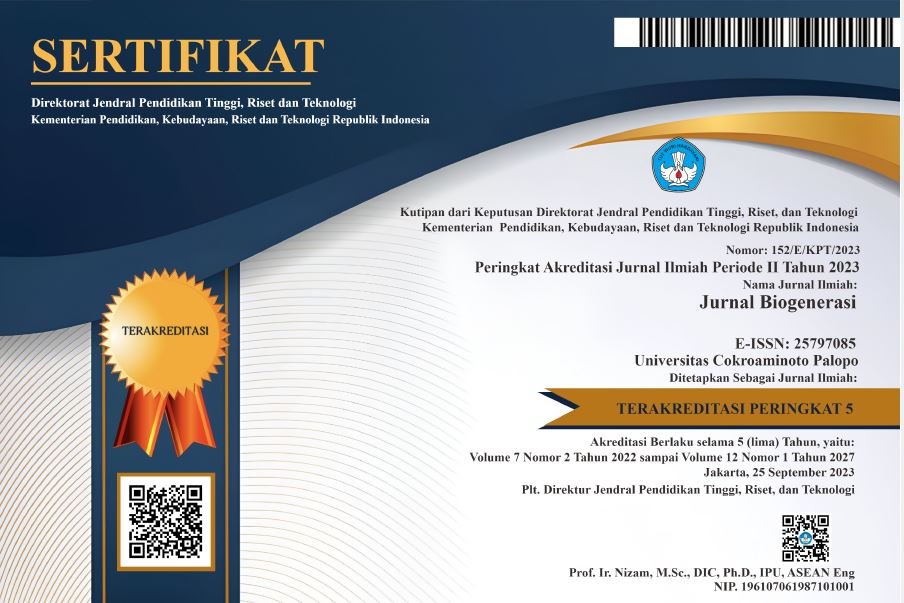ANALISIS POHON FILOGENETIK GEN ITS1 Amanita muscaria DARI BERBAGAI NEGARA
DOI:
https://doi.org/10.30605/biogenerasi.v10i2.5799Keywords:
Amanita muscaria, Genetic diversity, Phylogenetic treeAbstract
The purpose of this study is to determine the genetic diversity of the ITS1 gene from Amanita muscaria originating from various countries and create a phylogenetic tree based on ITS1 gene data to show the evolutionary relationship and distribution history of Amanita muscaria in various countries.The method used in this study is the Neighbor-Joining Method which is used to construct phylogenetic trees quickly and efficiently. Bootstrap tests (10,000 replicates) indicate the confidence level of the tree branches. Evolution was calculated using the Maximum Composite Likelihood method. The analysis involved 13 nucleotide sequences and was performed with MEGA11 software. The results of this study are The phylogenetic tree of Amanita muscaria shows two main clades with bootstrap values of 27 and 39, which reflect the level of confidence in the group of specimens. The first clade with a value of 27 includes specimens AB096048.1, AJ549964.1, AB080778.1, AB081295.1, and LN877747.1, while the second clade with a value of 39 includes AB015700.1, AB081294.1, AB080779.1, and AB080983.1. The branch with a bootstrap value of 63 shows greater genetic diversity. Specimens AB096048.1 and AJ549964.1 and AB080777.1 and AB096052.1 have very close evolutionary relationships.
Downloads
References
Barbare, J. (2022). Amanita sect. Phalloideae: Two interesting non-lethal species from West Africa. Mycological Progress. https://doi.org/10.1007/s11557-022-01778-0
Cao, J., Zhang, Z., Liu, D., Li, F., Cheng, X., Zhang, Y., Wang, H., Chang, Y., & Li, Z. (2009). ITS sequence analysis of 8 Amanita species from Tibetan and Yunnan. Journal of Yunnan University.
Felsenstein J. (1985). Confidence limits on phylogenies: An approach using the bootstrap. Evolution 39:783-791.
Liu, Y., Liu, J.-K., Kumla, J., Suwannarach, N., & Lumyong, S. (2023). Taxonomic novelties and new records of Amanita subgenus Amanitina from Thailand. Journal of Fungi. https://doi.org/10.3390/jof9060601
Milton, T. D., Park, S.-C., Wang, W. Y., Keller, N. P., & Pringle, A. (2023). Pangenomics of the death cap mushroom Amanita phalloides, and of Agaricales, reveals dynamic evolution of toxin genes in an invasive range. The ISME Journal. https://doi.org/10.1038/s41396-023-01432-x
Milton, T., Drott, S.-C., Park, Y., Wang, W., Harrow, L., Keller, N. P., & Pringle, A. (2023). Pangenomics of the death cap mushroom Amanita phalloides, and of Agaricales, reveals dynamic evolution of toxin genes in an invasive range. The ISME Journal. https://doi.org/10.1038/s41396-023-01432-x
Ramos A., López-Ramírez, F., Flores-Estévez, N., & Miguel, A. (2013). An approach to finding enzymatic restriction patterns for molecular characterization of Amanita muscaria. Journal of Food Agriculture & Environment.
Sa'adah, S., Hidayat, T., & Sudargo, F. (2015). Identifikasi miskonsepsi mahasiswa pendidikan biologi dalam memahami pohon filogenetika.
Saitou N. and Nei M. (1987). The neighbor-joining method: A new method for reconstructing phylogenetic trees. Molecular Biology and Evolution 4:406-425.
Tamura K., Nei M., and Kumar S. (2004). Prospects for inferring very large phylogenies by using the neighbor-joining method. Proceedings of the National Academy of Sciences (USA) 101:11030-11035.
Tamura K., Stecher G., and Kumar S. (2021). MEGA 11: Molecular Evolutionary Genetics Analysis Version 11. Molecular Biology and Evolution.
Vargas, N., Gonçalves, S. C., Franco-Molano, A. E., Restrepo, S., & Pringle, A. (2019). In Colombia the Eurasian fungus Amanita muscaria is expanding its range into native, tropical Quercus humboldtii forests. Mycologia.
Downloads
Published
How to Cite
Issue
Section
License
In submitting the manuscript to the journal, the authors certify that:
- They are authorized by their co-authors to enter into these arrangements.
- The work described has not been formally published before, except in the form of an abstract or as part of a published lecture, review, thesis, or overlay journal.
- That it is not under consideration for publication elsewhere,
- That its publication has been approved by all the author(s) and by the responsible authorities – tacitly or explicitly – of the institutes where the work has been carried out.
- They secure the right to reproduce any material that has already been published or copyrighted elsewhere.
- They agree to the following license and copyright agreement.
License and Copyright Agreement
Authors who publish with this journal agree to the following terms:
- Authors retain copyright and grant the journal right of first publication with the work simultaneously licensed under Creative Commons Attribution License (CC BY 4.0) that allows others to share the work with an acknowledgment of the work's authorship and initial publication in this journal.
- Authors are able to enter into separate, additional contractual arrangements for the non-exclusive distribution of the journal's published version of the work (e.g., post it to an institutional repository or publish it in a book), with an acknowledgment of its initial publication in this journal.
- Authors are permitted and encouraged to post their work online (e.g., in institutional repositories or on their website) prior to and during the submission process, as it can lead to productive exchanges, as well as earlier and greater citation of published work.


.png)

